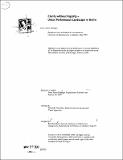Clarity without rigidity : urban performance landscape in Berlin
Author(s)
Danziger, Jason Aaron, 1970-
DownloadFull printable version (26.88Mb)
Advisor
Fernando Domeyko.
Terms of use
Metadata
Show full item recordAbstract
"What is necessary, is an incomplete design; a design that has clarity without rigidity; one that could be called 'open' as against 'shut'. This is the essence of theatrical thinking: a true theater designer will think of their designs as being all the time in motion, in action ... " -- Peter Brook, The Empty Space. (1980). "What interests me is the opportunity for all of us to become something different from what we are, by constructing spaces that contribute something to the experience of who we are ... " -- Richard Serra, Torqued Ellipses. (1997). This project is an urban landscape: a proposal to strengthen the stance of the famous Theater am Schiffbauerdamm towards the city of Berlin and provide a connection to the Spree River. Historic forces (such as the wholesale destruction of the fabric of Berlin during the bombing raids at the close ofWWII), as well as a current reading of the city, shape and inform the design; while the theater itself provides great inspiration and guidance. The proposal transforms the core of the block containing Bertolt Brecht's Berliner Ensemble into a network (rhizome) of stages, aiming to provide focus at large for the theater community of Berlin as well as a public garden to be used by local residents when no performances are occurring. Conceptually, Brecht's subversive attitude towards political power structures as well as his concept of Verfremdungs (alienation) provide a bridge into the (phenomenological) design; Oscar Schlemmer focuses on the relationship between actor and audience and the importance of the stage as a place of ritual for our culture. Richard Serra informs the design in terms of mass, ~n, and intensity. Adolphe Appia provides a form language for performance which can easily flow into the garden ...
Description
Thesis (M. Arch.)--Massachusetts Institute of Technology, Dept. of Architecture, 1998. Includes bibliographical references (p. 147-157).
Date issued
1998Department
Massachusetts Institute of Technology. Department of ArchitecturePublisher
Massachusetts Institute of Technology
Keywords
Architecture